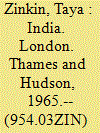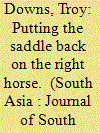| Srl | Item |
| 1 |
ID:
040198


|
|
India
/ Zinkin, Taya
|
1965

|
|
|
|
| Publication |
London, Thames and Hudson, 1965.
|
| Description |
236p.: ill., mapshbk
|
|
|
|
|
|
|
|
|
|
|
|
Copies: C:1/I:0,R:0,Q:0
Circulation
| Accession# | Call# | Current Location | Status | Policy | Location |
| 000569 | 954.03/ZIN 000569 | Main | On Shelf | General | |
|
|
|
|
| 2 |
ID:
131913


|
|
|
|
|
| Publication |
2014.
|
| Summary/Abstract |
Standard historical accounts of the Indian Revolt of 1857-58 give the impression that superiority on the battlefield accounted for the ability of the British to defeat their Indian adversaries. Yet, to focus solely on the military campaigns ignores the intricate and multifaceted nature of the British response to the Revolt. Aside from armed force, a number of counter-insurgency strategies were used to suppress rebellion in the countryside. This paper assesses the intent and effectiveness of these measures by looking at how officials responded to the outbreak of large-scale and protracted rural insurgency in the districts of the Benares Division. It is argued that these measures achieved a far greater degree of success in curtailing acts of rural insurgency than the use of military force.
|
|
|
|
|
|
|
|
|
|
|
|
|
|
|
|
| 3 |
ID:
188399


|
|
|
|
|
| Summary/Abstract |
Is dakaiti in Central and North India a unique form of banditry? Can social banditry exist in a caste-oriented society? How have normative, discursive and moral structures interacted with dakaiti in India? What was the relationship between dakait bands, the state and society—symbiotic, incompatible, or something else? These are a few of the questions this study explores. Dakaiti in India not only begets a new definition of social banditry that challenges Hobsbawm’s assertion that the phenomenon may only transpire in a premodern and pre-industrial society, but also Blok’s argument, contra Hobsbawm, that bandits—as ‘champions of the poor’—are chimerical. Placing excessive emphasis on caste, however, has two main consequences. First, it makes it difficult to recognise social banditry in India and, second, as a result, the causes of the noteworthy decline of dakaiti in India in the 2000s are obscured.
|
|
|
|
|
|
|
|
|
|
|
|
|
|
|
|